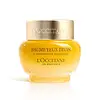What's inside
What's inside
 Key Ingredients
Key Ingredients

 Benefits
Benefits

 Concerns
Concerns

 Ingredients Side-by-side
Ingredients Side-by-side

Water
Skin ConditioningGlycerin
HumectantButylene Glycol
HumectantCyclopentasiloxane
EmollientCyclohexasiloxane
EmollientChenopodium Quinoa Seed Extract
Skin ConditioningMagnesium Sulfate
Zinc Sulfate
AntimicrobialManganese Sulfate
Skin ConditioningCalcium Chloride
AstringentAscorbyl Glucoside
AntioxidantVaccinium Myrtillus Fruit/Leaf Extract
AstringentSaccharum Officinarum Extract
MoisturisingCitrus Medica Limonum Fruit Extract
Skin ConditioningCitrus Aurantium Dulcis Fruit Extract
MaskingAcer Saccharum Extract
Skin ConditioningHydroxyethyl Acrylate/Sodium Acryloyldimethyl Taurate Copolymer
Emulsion StabilisingDimethicone Crosspolymer
Emulsion StabilisingPolyacrylate-13
Pentaerythrityl Tetraethylhexanoate
EmollientHydrogenated Vegetable Oil
EmollientPCA Dimethicone
Skin ConditioningPEG-100 Stearate
Cyclomethicone
EmollientGlyceryl Stearate
EmollientPolyisobutene
Dimethiconol
EmollientDimethicone
EmollientPhenyl Trimethicone
Skin ConditioningEthylhexylglycerin
Skin ConditioningPolysorbate 20
EmulsifyingAcrylates/C10-30 Alkyl Acrylate Crosspolymer
Emulsion StabilisingTromethamine
BufferingDisodium EDTA
Parfum
MaskingWater, Glycerin, Butylene Glycol, Cyclopentasiloxane, Cyclohexasiloxane, Chenopodium Quinoa Seed Extract, Magnesium Sulfate, Zinc Sulfate, Manganese Sulfate, Calcium Chloride, Ascorbyl Glucoside, Vaccinium Myrtillus Fruit/Leaf Extract, Saccharum Officinarum Extract, Citrus Medica Limonum Fruit Extract, Citrus Aurantium Dulcis Fruit Extract, Acer Saccharum Extract, Hydroxyethyl Acrylate/Sodium Acryloyldimethyl Taurate Copolymer, Dimethicone Crosspolymer, Polyacrylate-13, Pentaerythrityl Tetraethylhexanoate, Hydrogenated Vegetable Oil, PCA Dimethicone, PEG-100 Stearate, Cyclomethicone, Glyceryl Stearate, Polyisobutene, Dimethiconol, Dimethicone, Phenyl Trimethicone, Ethylhexylglycerin, Polysorbate 20, Acrylates/C10-30 Alkyl Acrylate Crosspolymer, Tromethamine, Disodium EDTA, Parfum
Water
Skin ConditioningButyrospermum Parkii Butter
Skin ConditioningTheobroma Cacao Fruit Powder
Skin ConditioningCaprylyl Caprylate/Caprate
EmollientGlycerin
HumectantRosa Centifolia Flower Water
Skin ConditioningCetearyl Alcohol
EmollientSilica
AbrasiveOenothera Biennis Oil
EmollientGlyceryl Stearate
EmollientPEG-100 Stearate
Camelina Sativa Seed Oil
Skin ConditioningHelichrysum Italicum Flower Oil
MaskingHelichrysum Italicum Flower/Stem Extract
Skin ConditioningHelichrysum Italicum Extract
AntiseborrhoeicEchium Plantagineum Seed Oil
Skin ConditioningBorago Officinalis Seed Oil
EmollientMyrtus Communis Oil
MaskingHelianthus Annuus Seed Oil
EmollientAdenosine
Skin ConditioningHyaluronic Acid
HumectantEscin
TonicMethyl Methacrylate Crosspolymer
Hydroxyethyl Acrylate/Sodium Acryloyldimethyl Taurate Copolymer
Emulsion StabilisingCeteareth-33
CleansingCaprylyl Glycol
EmollientEthylhexylglycerin
Skin ConditioningTocopherol
AntioxidantXanthan Gum
EmulsifyingDisodium EDTA
Sorbitan Isostearate
EmulsifyingPolysorbate 60
EmulsifyingCaprylic/Capric Triglyceride
MaskingSucrose Palmitate
EmollientSodium Hydroxide
BufferingGlyceryl Linoleate
EmollientCitric Acid
BufferingSodium Benzoate
MaskingPhenoxyethanol
PreservativePotassium Sorbate
PreservativeWater, Butyrospermum Parkii Butter, Theobroma Cacao Fruit Powder, Caprylyl Caprylate/Caprate, Glycerin, Rosa Centifolia Flower Water, Cetearyl Alcohol, Silica, Oenothera Biennis Oil, Glyceryl Stearate, PEG-100 Stearate, Camelina Sativa Seed Oil, Helichrysum Italicum Flower Oil, Helichrysum Italicum Flower/Stem Extract, Helichrysum Italicum Extract, Echium Plantagineum Seed Oil, Borago Officinalis Seed Oil, Myrtus Communis Oil, Helianthus Annuus Seed Oil, Adenosine, Hyaluronic Acid, Escin, Methyl Methacrylate Crosspolymer, Hydroxyethyl Acrylate/Sodium Acryloyldimethyl Taurate Copolymer, Ceteareth-33, Caprylyl Glycol, Ethylhexylglycerin, Tocopherol, Xanthan Gum, Disodium EDTA, Sorbitan Isostearate, Polysorbate 60, Caprylic/Capric Triglyceride, Sucrose Palmitate, Sodium Hydroxide, Glyceryl Linoleate, Citric Acid, Sodium Benzoate, Phenoxyethanol, Potassium Sorbate
Ingredients Explained
These ingredients are found in both products.
Ingredients higher up in an ingredient list are typically present in a larger amount.
Disodium EDTA plays a role in making products more stable by aiding other preservatives.
It is a chelating agent, meaning it neutralizes metal ions that may be found in a product.
Disodium EDTA is a salt of edetic acid and is found to be safe in cosmetic ingredients.
Learn more about Disodium EDTAEthylhexylglycerin (we can't pronounce this either) is commonly used as a preservative and skin softener. It is derived from glyceryl.
You might see Ethylhexylglycerin often paired with other preservatives such as phenoxyethanol. Ethylhexylglycerin has been found to increase the effectiveness of these other preservatives.
Glycerin is already naturally found in your skin. It helps moisturize and protect your skin.
A study from 2016 found glycerin to be more effective as a humectant than AHAs and hyaluronic acid.
As a humectant, it helps the skin stay hydrated by pulling moisture to your skin. The low molecular weight of glycerin allows it to pull moisture into the deeper layers of your skin.
Hydrated skin improves your skin barrier; Your skin barrier helps protect against irritants and bacteria.
Glycerin has also been found to have antimicrobial and antiviral properties. Due to these properties, glycerin is often used in wound and burn treatments.
In cosmetics, glycerin is usually derived from plants such as soybean or palm. However, it can also be sourced from animals, such as tallow or animal fat.
This ingredient is organic, colorless, odorless, and non-toxic.
Glycerin is the name for this ingredient in American English. British English uses Glycerol/Glycerine.
Learn more about GlycerinGlyceryl Stearate is a mix of glycerin and stearic acid.
It is used to stabilize the mixing of water and oil ingredients. By preventing these ingredients from separating, it can help elongate shelf life. It can also help thicken the product's texture.
As an emollient, it helps soften skin and supports barrier-replenishing ingredients.
In cosmetics, Glyceryl Stearate is often made from vegetable oils or synthetically produced.
This ingredient may not be fungal-acne safe
Fun fact: The human body also creates Glyceryl Stearate naturally.
Learn more about Glyceryl StearateThis is a synthetic polymer. It helps improve the texture of products by adding thickness and gel-like feel.
It is also an emulsifer, meaning it prevents ingredients such as oil and water from separating. It also helps evenly disperse other ingredients.
Peg-100 Stearate is an emollient and emulsifier. As an emollient, it helps keep skin soft by trapping moisture in. On the other hand, emulsifiers help prevent oil and water from separating in a product.
PEGS are a hydrophilic polyether compound . There are 100 ethylene oxide monomers in Peg-100 Stearate. Peg-100 Stearate is polyethylene glycol ester of stearic acid.
Water. It's the most common cosmetic ingredient of all. You'll usually see it at the top of ingredient lists, meaning that it makes up the largest part of the product.
So why is it so popular? Water most often acts as a solvent - this means that it helps dissolve other ingredients into the formulation.
You'll also recognize water as that liquid we all need to stay alive. If you see this, drink a glass of water. Stay hydrated!
Learn more about Water